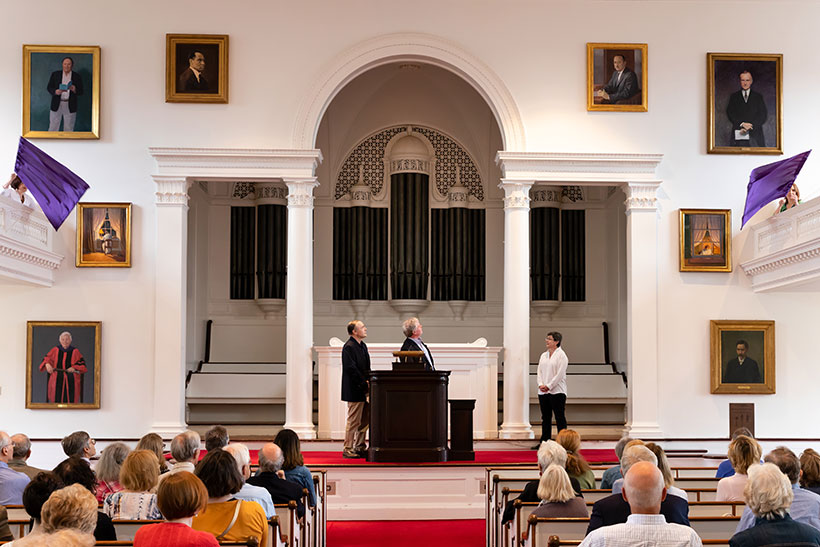
A Charm invests a face
Imperfectly beheld —
The Lady dare not lift her Veil
For fear it be dispelled —
But peers beyond her mesh —
And wishes — and denies —
Lest Interview — annul a want
That Image — satisfies —

A Charm invests a face
Imperfectly beheld —
The Lady dare not lift her Veil
For fear it be dispelled —
But peers beyond her mesh —
And wishes — and denies —
Lest Interview — annul a want
That Image — satisfies —
How do you paint a portrait of someone who spent much of her life not wishing to be seen, and who has been dead for over 130 years? If the subject in question is Emily Dickinson, and you’ve been asked by Amherst College to afford the poet a long-overdue honor, you find a way. Robert Sweeney, the William R. Mead Professor of Art, did.
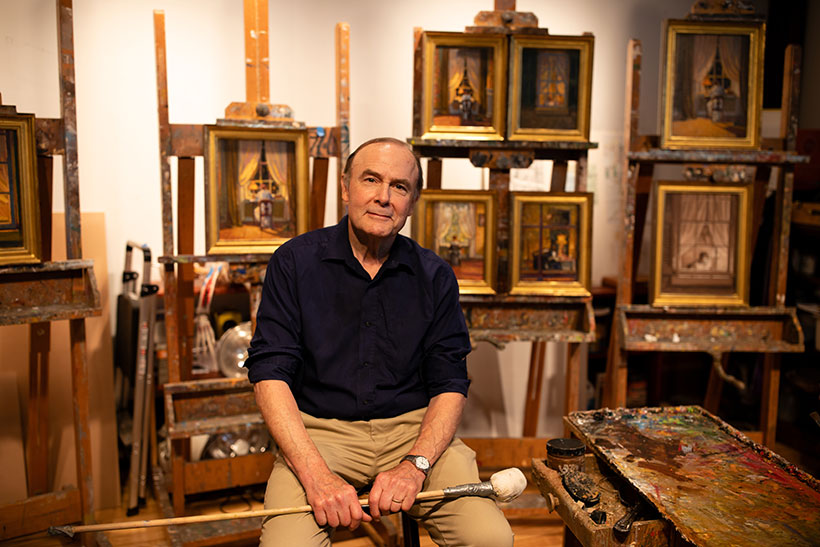
The artist, Robert T. Sweeney, the William R. Mead Professor of Art, in his studio in Fayerweather Hall.
In a June 21 ceremony that filled Johnson Chapel with administrators and staff from the College and the Emily Dickinson Museum, Dickinson became the second—and third—woman to have her picture added to the gallery of College presidents, noted faculty and honored alumni on the walls of the chapel. With Sweeney’s two new paintings at the head of the chapel, the poet joins Rose Olver, the first woman to hold a tenure-track position on the faculty, whose portrait joined the collection in 2013.
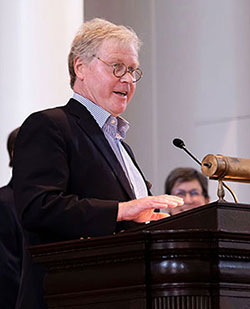
Upon becoming chairman of the Board, Murphy brought up the question, “Wouldn’t it be a good idea to finally rectify this absence?”
“Amherst has always been a ‘writing college,’ and has long been associated with some of the world’s greatest poets in particular,” Murphy said. So why not a place for Emily?
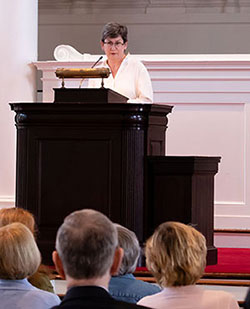
“She and Amherst College grew up together,” Wald said. “The College, almost as literally as she, could claim to be a child of the Dickinson family.” The portrait project gathered steam in earnest with the enthusiastic approval of President Biddy Martin.
In keeping with the air of mystery that continues to surround the very private and enigmatic poet, the College commissioned not one but two paintings, neither of which is a full-on portrait in the traditional sense.
To paint Amherst’s famous recluse in her prime, the artist faces the challenge that the most recognizable and verifiable image we have of Emily Dickinson is the lone picture taken of her when she was 16. It’s a portrait which she reportedly didn’t like, and which her family, arguing that the 1847 daguerreotype wasn’t a good likeness of her, would doctor for editions of her work after her death, adding curls and frills.
Other photos alleged to show an adult Dickinson have surfaced over the years, but even the most likely candidate, a photo that surfaced in 2012, apparently showing Dickinson in her prime, remains a subject of debate.
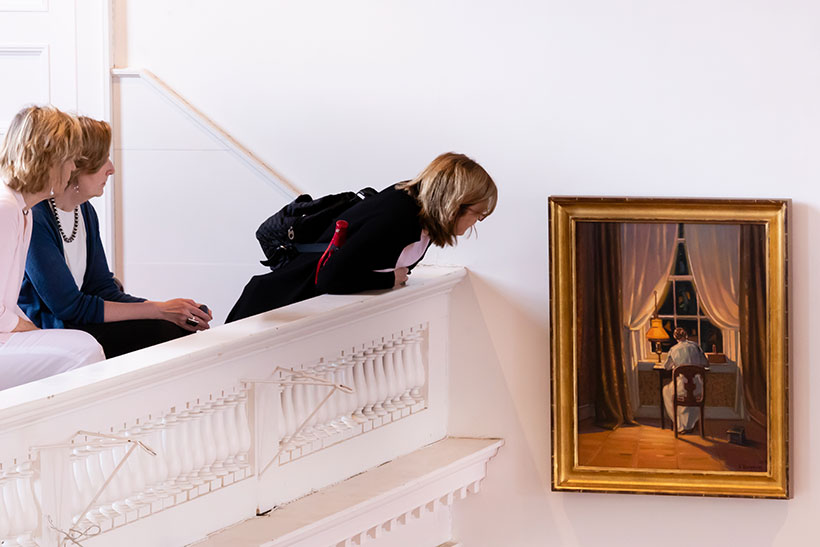
Nevertheless, there remains ample material for a portrait artist to build upon: Dickinson’s poems, the Homestead where she wrote, the white dress she wore through many of her years of seclusion, and a lock of her hair, preserved in all its chestnut redness in Amherst College’s Archives and Special Collections.
Sweeney says his portraits are also informed by his studies of the museum. “Her bedroom had just recently been restored to the original wallpaper, curtain designs.”
Murphy said that he and Sweeney “began to wonder if there might be an oblique way of creating a portrait—a way of capturing her both ‘inside’ and ‘outside’ … a portrait that did not pretend to know more than we can, and yet somehow captured as much of what we can know as possible.”
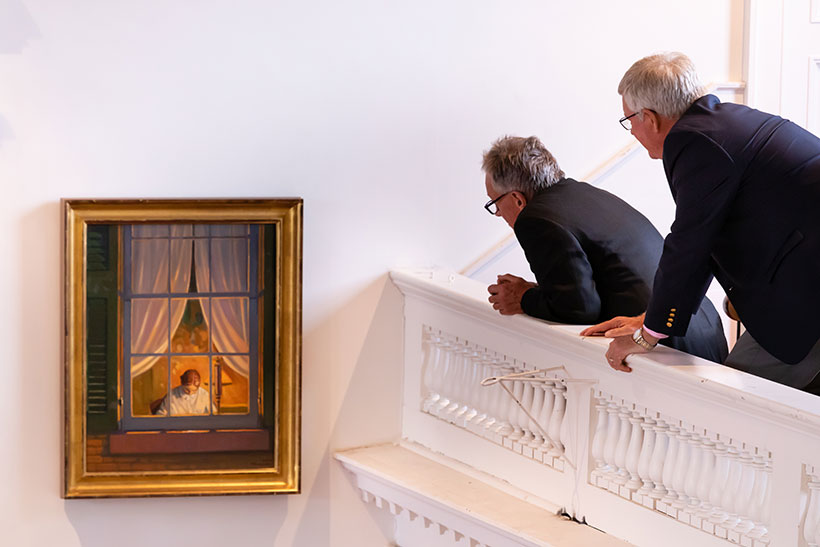
Those discussions resulted in a plan for two portraits of approximately the same scene: Dickinson as seen at her table from behind, inside her bedroom; and Dickinson from outside the bedroom window.
Sweeney started working on initial studies in December, starting with small 9-inch-by-12-inch canvases, working up to 12-by-16. The final paintings, measuring 24 by 30 inches, were finished in late May.
“What I really liked about it was it took me completely out of my normal realm,” said Sweeney, whose commissioned work includes a portrait of Amherst’s 17th president, Tom Gerety (1994-2003), also in the Chapel.
Settling on a nighttime setting for the paintings (Dickinson often wrote in the wee hours), “that sense of light was really what I organized the paintings around,” Sweeney said: “Very warm light, creating rather pronounced shadows.”
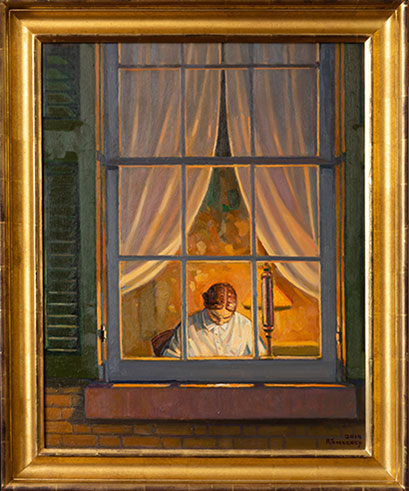
Internal Light (see larger version)

Evening Reflections (see larger version)
Dickinson herself helped Sweeney along, through two of her poems. For Internal Light, the painting which looks in on her from outside her window, he struggled with accurately portraying her lamp, and kept in mind her lines, “At last to be identified! / At last the lamps upon thy side / The rest of Life to see!”
For the interior painting looking out, Evening Reflections, he focused on the basket that the poet was known to lower out the window, filled with treats, to children below: “My Basket holds — just — Firmaments — / Those — dangle easy — on my arm, / But smaller bundles — Cram.”
“What strikes me about these portraits is that we see a posture unlike others on these walls,” said Wald. “We see a poet at work, a woman at work. The portraits pulse with warmth and vigorous creative activity in the solitude of Dickinson’s own room.”
“I love the way Bob Sweeney has preserved this sense of solitude and self-reliance by not revealing her face to us,” she added.
For Sweeney, Dickinson’s ability to pack meaning into a simple detail made a difference.
“What I like about her poetry are the pictures she paints in little pieces, right in those poems,” he said. “The funny little reference that doesn’t mean anything at first, and then it kind of comes back around and you say, ‘Ah, that makes sense.’”
“Emily Dickinson’s poetry is timeless, and it took courage and integrity to produce it. It’s that greatness that makes her presence here in Johnson Chapel so proper,” Wald said. “She once wrote, ‘If fame belonged to me, I couldn’t escape her.’ She’s exactly right. Fame does belong to her, and she can’t escape it.”